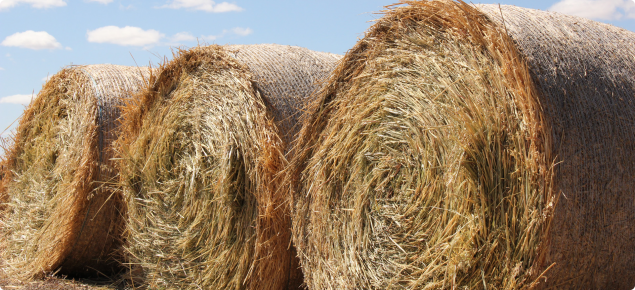When to cut hay
Export markets demand bright green, dry hay. Selecting appropriate cutting time is critical in achieving this standard whilst maintaining hay yield and quality.
When planning for hay cutting it is important to consider rain events. Rain over 12mm on cut hay may drastically downgrade it compared to hay left standing for an extra two weeks.
Research has shown that the optimum time for cutting oaten hay is at the watery ripe stage (Z71), the earliest stage of milk development. Cutting at this stage will deliver the best compromise between yield and quality. Many processors recommend cutting at this stage as quality declines significantly after the water ripe stage. Some processors however may prefer hay cut at a different development stage, so check with your exporter before cutting.
When monitoring hay crops to determine when to cut:
- Walk into the crop and check a number of areas of the paddock.
- Take the top floret and squeeze between the tops of your fingers.
- A watery green substance will come out when it is at the watery ripe stage (Z71).
- Check the crop every two days and then daily as development gets closer.
- Organise contractors to cut hay as soon as possible after water ripe, keeping in mind rainfall events.
Some hay varieties (such as Winteroo) maintain a green plant colour throughout the milky dough stage. This has seen growers cut too late late and deliver poor quality hay. These varieties needs to monitored to ensure they are cut at the right time to optimise quality.
Storing hay
It is important to have hay in storage as soon as possible after baling to prevent any further damage from weather.
Many hay exporters will require growers to store hay for long periods of time (which may attract a premium on top of the graded price) as they can only handle so much hay at a time.
It is therefore important to have adequate storage to prevent weather damage (sun, rain and wind). Sheds should have at least three walls (with the opening facing away from prevailing weather) and if floors are not concrete, black plastic should be used to prevent moisture from the bare ground rising into the bales. Moisture affected bales will be rejected for export. Shed layouts should also provide adequate air flow throughout the stack to provide for the dissipation of any heated hay which can eventually lead to spontaneous combustion.
Preventing shed fires
(Source: Australian Fodder Industry Association).
Spontaneous combustion is a common cause of hay fires. In the rush of hay making, with impending rain, farmers and contractors are under great pressure to complete hay baling and have hay 'safely' in the shed. In this haste, problems can occur and high moisture hay can lead to spontaneous combustion and loss of valuable hay and sheds.
- Time line - Spontaneous fires in stacked hay do not usually occur in less than 10-14 days after stacking and generally require 5-10 weeks. Under ideal conditions of moisture and high ambient temperatures ignition has been observed in 6-7 days.
- Monitoring (a simple test) - The temperature of a stack may be checked by the use of a 'temperature probe', a crow bar or other piece of steel. The bars should be left in place and checked regularly. A pipe or tubing should not be used as this may entrain air into the stack and cause ignition to occur. The feel of the bar and corresponding temperatures are:
- Comfortable = 27-38°C
- Tolerable = 38-55°C
- Tolerable for a short time = 55-60°C
- Tolerable to touch only = 60-66°C
- Too hot to touch and above the danger point = 71°C+
Any stack that is known to be heating should be checked even more regularly to determine if temperatures are rising or falling. If the stacks continues to rise the only solution is to pull it apart. Water and fire fighting equipment should always be on hand to extinguish a possible fire. Bales that have reached a high enough temperature may ignite as they are introduced to a more available oxygen supply.
Silage
Information on silage, including production, quality, harvest and storage can be found on the Australian Fodder Industry Association website.


